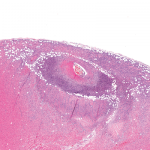Interventions
Glucocorticoids—The current standard treatment for GCA involves the timely administration of high-dose glucocorticoids. Recommendations are to start glucocorticoids when GCA is suspected, even prior to diagnosis confirmation with a temporal artery biopsy.8
When severe complications, such as vision loss, cerebral ischemia, cardiovascular ischemia or limb ischemia, are suspected, treatment with intravenous methylprednisolone at 500–1,000 mg/day for three days is recommended to reduce inflammation because glucocorticoids have good central nervous system (CNS) penetration and tend to have rapid onset.
For patients without severe complications, high-dose oral glucocorticoids are sufficient. Evidence also indicates that outcomes are better when tocilizumab is added.9
If a patient has a symptom relapse while being treated with intravenous glucocorticoids, the addition of a glucocorticoid-sparing agent, such as tocilizumab, is recommended. For patients with cranial ischemia, a glucocorticoid with higher mineralocorticoid activity may be added to reduce intracranial pressure.
Because high doses of glucocorticoids are used in GCA treatment, patients are more vulnerable to their side effects, such as hyperglycemia/diabetes mellitus, hypertension, fractures, gastrointestinal bleeding, sleeplessness, mood disturbances, cataracts, infections and psychosis. Relapse is a risk, even with normalized inflammatory markers, making it difficult for some patients to completely stop glucocorticoid therapy.10,11 Nevertheless, the benefit of glucocorticoids in the treatment of GCA likely outweighs the risk of complications when ischemia or vision loss are threatened.8
Cyclophosphamide—Tocilizumab is the most commonly used glucocorticoid-sparing agent for GCA. Another option is cyclophosphamide. An alkylating agent that inhibits protein synthesis by crosslinking DNA and RNA, cyclophosphamide is commonly used for malignant lymphomas and is approved by the U.S. Food & Drug Administration to treat breast cancer, disseminated neuroblastomas, retinoblastoma, minimal change nephrotic syndrome and ovarian adenocarcinomas.12 Because it’s a potent immune modulator, cyclophosphamide has been used in a variety of vasculitides, such as GCA.
Patients who are at high risk of, or have experienced, glucocorticoid-related adverse effects and have not had an appropriate response with other glucocorticoid-sparing treatments may benefit from treatment with cyclophosphamide. An observational study showed some efficacy of cyclophosphamide in 103 patients with GCA who had developed an intolerance to glucocorticoid treatment, relapsed or developed glucocorticoid dependency.13 Of these patients, 22% relapsed despite treatment and 78% responded to cyclophosphamide.13 Further of the 103 patients reviewed, 39% reported side effects with cyclophosphamide, including cytopenias and infections, with 12.6% of the patients discontinuing treatment due to these side effects.13
Tocilizumab—Another agent becoming more widely used to treat GCA is the interleukin (IL) 6 antagonist tocilizumab, with an improved side effect profile and decreased administration frequency. Tocilizumab is available as a once-weekly subcutaneous injection or a monthly intravenous infusion. The most common serious adverse events associated with its use include serious infections, gastrointestinal perforation, malignancy, myocardial infarction and cerebrovascular accidents.14 Although tocilizumab has only been studied in combination with initial prednisone therapy, it has demonstrated a higher rate of sustained remission than prednisone alone.9,15

